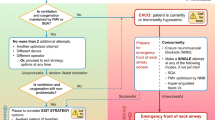Abstract
Infants with congenital diaphragmatic hernia (CDH) who require non-invasive positive pressure ventilation or high flow nasal cannula are at risk for aspiration and delayed initiation of oral feeding. We developed a dysphagia provider-led protocol that involved early consultation with an occupational therapist or speech/language pathologist and modified barium swallow study (MBSS) to assess for readiness for oral feeding initiation/advancement on non-invasive positive pressure ventilation. The objective of this study was to retrospectively compare this intervention cohort to a historical control cohort to evaluate the protocol’s impact on the time to initiate oral feeding. We describe the development and implementation of the protocol, the MBSS findings of the intervention cohort, and compared the control (n = 64) and intervention (n = 37) cohorts using Fischer’s exact test and Mann–Whitney test. We found that both cohorts had similar prenatal and neonatal characteristics including age at extubation. Significantly more infants in the intervention cohort were on non-invasive positive pressure ventilation or high flow nasal cannula at the time of oral feeding initiation (84% vs. 28%, p < 0.0001). None of the control cohort infants underwent MBSS while on respiratory support. Of the intervention cohort, 15 infants underwent a MBSS while on non-invasive positive pressure ventilation; 6 had no evidence of laryngeal penetration and/or aspiration during swallowing. Infants in the control cohort initiated oral feeds significantly sooner after extubation (6 versus 11 days, p = 0.001) and attained full oral feeds earlier (20 days versus 28 days, p = 0.02) than the intervention group. There was no difference in the rate of gastrostomy tube placement (38%). Appropriate monitoring by a dysphagia provider and evaluation with clinical and radiological means are crucial to determine the safety of initiating oral feeding in term infants with CDH. Continued surveillance is needed to determine the long-term impact on oral feeding progression in this population.


Similar content being viewed by others
References
Migliazza L, Bellan C, Alberti D, Auriemma A, Burgio G, Locatelli G, et al. Retrospective study of 111 cases of congenital diaphragmatic hernia treated with early high-frequency oscillatory ventilation and presurgical stabilization. J Pediatr Surg. 2007;42(9):1526–32.
Rudra S, Adibe OO, Malcolm WF, Smith PB, Cotten CM, Greenberg RG. Gastrostomy tube placement in infants with congenital diaphragmatic hernia: frequency, predictors, and growth outcomes. Early Hum Dev. 2016;103:97–100.
Vu LT, McFarland C, Bratton B, Lee H. Closer look at the nutritional outcomes of patients after primary repair of congenital diaphragmatic hernia. J Pediatr Gastroenterol Nutr. 2017;65(2):237–41.
Goday PS, Huh SY, Silverman A, Lukens CT, Dodrill P, Cohen SS, et al. Pediatric Feeding Disorder: Consensus Definition and Conceptual Framework. J Pediatr Gastroenterol Nutr. 2019;68(1):124–9.
Kurtz JD, Chowdhury SM, Woodard FK, Strelow JR, Zyblewski SC. Factors associated with delayed transition to oral feeding in infants with single ventricle physiology. J Pediatr. 2019;211:134–8.
Ferrara L, Bidiwala A, Sher I, Pirzada M, Barlev D, Islam S, et al. Effect of nasal continuous positive airway pressure on the pharyngeal swallow in neonates. J Perinatol. 2017;37(4):398–403.
Canning A, Fairhurst R, Chauhan M, Weir KA. Oral feeding for infants and children receiving nasal continuous positive airway pressure and high-flow nasal cannula respiratory supports: a survey of practice. Dysphagia. 2020;35(3):443–54.
Cichero JAY, Lam PTL, Chen J, Dantas RO, Duivestein J, Hanson B, et al. Release of updated International Dysphagia Diet Standardisation Initiative Framework (IDDSI 2.0). J Texture Stud. 2020;51(1):195–6.
Raczynska A, Gulczynska E. The impact of positioning on bottle-feeding in preterm infants (</= 34 GA). A comparative study of the semi-elevated and the side-lying position—a pilot study. Dev Period Med. 2019;23(2):117–24.
Park J, Pados BF, Thoyre SM. Systematic review: what is the evidence for the side-lying position for feeding preterm infants? Adv Neonatal Care. 2018;18(4):285–94.
Jadcherla SR, Bhandari V. “Pressure” to feed the preterm newborn: associated with “positive” outcomes? Pediatr Res. 2017;82(6):899–900.
Dumpa V, Kamity R, Ferrara L, Akerman M, Hanna N. The effects of oral feeding while on nasal continuous positive airway pressure (NCPAP) in preterm infants. J Perinatol. 2020;40(6):909–15.
Leibel SL, Castro M, McBride T, Hassall K, Sarmiento K, Ye XY, et al. Comparison of Continuous positive airway pressure versus High flow nasal cannula for Oral feeding Preterm infants (CHOmP): randomized pilot study. J Matern Fetal Neonatal Med. 2020. https://doi.org/10.1080/14767058.2020.1735339.
Hanin M, Nuthakki S, Malkar MB, Jadcherla SR. Safety and efficacy of oral feeding in infants with BPD on nasal CPAP. Dysphagia. 2015;30(2):121–7.
Wong MKW, Haliburton B, Graham A, Lapidus-Krol E, Moraes TJ, Marcon MA, et al. Requirement and duration of tube feed supplementation among congenital diaphragmatic hernia patients. J Pediatr Surg. 2019;54(5):895–8.
Manani M, Jegatheesan P, DeSandre G, Song D, Showalter L, Govindaswami B. Elimination of admission hypothermia in preterm very low-birth-weight infants by standardization of delivery room management. Perm J. 2013;17(3):8–13.
Haddock C, Al Maawali AG, Ting J, Bedford J, Afshar K, Skarsgard ED. Impact of multidisciplinary standardization of care for gastroschisis: treatment, outcomes, and cost. J Pediatr Surg. 2018;53(5):892–7.
Bence CM, Rymeski B, Gadepalli S, Sato TT, Minneci PC, Downard C, et al. Clinical outcomes following implementation of a management bundle for esophageal atresia with distal tracheoesophageal fistula. J Pediatr Surg. 2021;56(1):47–54.
Funding
This project was supported by the National Institutes of Health Grant Number T32AI125222. The content is solely the responsibility of the authors and does not necessarily represent the official views of the National Institutes of Health.
Author information
Authors and Affiliations
Corresponding author
Ethics declarations
Conflict of interest
None of the authors have any conflicts of interest to disclose.
Additional information
Publisher's Note
Springer Nature remains neutral with regard to jurisdictional claims in published maps and institutional affiliations.
Supplementary Information
Below is the link to the electronic supplementary material.
Rights and permissions
About this article
Cite this article
Schwab, M.E., Crennan, M., Burke, S. et al. Oral Feeding in Infants After Congenital Diaphragmatic Hernia Repair While on Non-invasive Positive Pressure Ventilation: The Impact of a Dysphagia Provider-Led Protocol. Dysphagia 37, 1305–1313 (2022). https://doi.org/10.1007/s00455-021-10391-4
Received:
Accepted:
Published:
Issue Date:
DOI: https://doi.org/10.1007/s00455-021-10391-4




